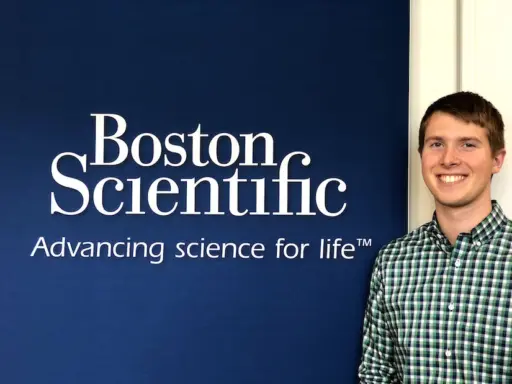Like the rest of his fellow seniors studying biomedical engineering at the University of Wisconsin-Madison, Leo Steiner spent the fall 2019 semester immersed in a complex design project.
Yearlong senior capstone design projects are the culmination of four years of skill and knowledge development within the Department of Biomedical Engineering’s unique design-intensive undergraduate curriculum. And Steiner and his group mates—Elise Gendreau, Sam Parmentier, Ryan Yost and Ashley Zagaros—certainly took on an ambitious endeavor: prototyping and testing a neurovascular catheter capable of navigating through the brain’s blood vessels to deliver treatments for ischemic stroke.
 Leo Steiner at Boston Scientific.
Leo Steiner at Boston Scientific.
However, Steiner dug into that challenge from nearly 250 miles away from campus—using his cooperative education post at medical device company Boston Scientific in Maple Grove, Minnesota, as an opportunity to learn from industry-seasoned engineers, try high-end fabrication techniques and put prototypes through advanced testing.
That kind of direct involvement with an industry leader is a priority for BME. By connecting students with major companies and promising startups alike, the department hopes to augment the undergraduate design experience while opening the door for more and more graduates to quickly launch their careers.
Since 2010, the percentage of BME graduates moving directly into industry—as opposed to entering graduate programs or medical school—has trended upward. In 2010, that number was 32%; in 2019, it was 45%, and had twice topped 50% in the previous four years.
And while BME isn’t trying to nudge undergraduates away from further schooling, the department is keen to help students who are interested in starting careers in industry immediately after graduation by forging ties with a range of companies. Madison’s geographic location between the Twin Cities, Milwaukee and Chicago—a “life sciences alley,” if you will—is a boon to those efforts.
“We’ve started to establish these pipelines,” says Justin Williams, the Peter Tong Department Chair and Vilas Distinguished Achievement Professor.
The design program is a key connection point with leading companies such as Boston Scientific and GE Healthcare and emerging startups based in UW-Madison’s University Research Park or further afield. In fall 2019, eight companies sponsored design projects, more than any previous session. Alumni are often the conduits, particularly as BME—which launched in 1999—has grown and matured as a department.
The fact that the BME design program spans the curriculum is appealing to companies, notes John Puccinelli, associate chair of the BME undergraduate program and curriculum advisor, instructor and coordinator of the design program.
“It’s a win-win,” he says. “Companies get a chance to try out some of our students in BME design while they’re sophomores or juniors. And, from a project standpoint, they get a chance to maybe go down avenues that they don’t have the budget for potentially or necessarily the time to invest a full person on.”
In Steiner’s case, his group’s project provided a chance for Boston Scientific to delve into neurovascular catheters, which Steiner calls a novel space for the company despite its extensive experience with catheters in general.
And, in addition to sharpening his fabrication skills, understanding of the development process, and knowledge of the business side of creating a device, Steiner got a glimpse into daily life at a large medical company.
After graduating in December 2020, he’s planning to pursue a PhD to further develop his technical acumen. But he’s interested in returning to industry—and perhaps Boston Scientific, where he’ll intern again during the summer of 2020—after completing his doctoral studies.
“I was really able to understand what it means to be a successful biomedical or electrical engineer in a medical device company,” he says. “I was also able to just learn more about my passions and where I want to be moving forward. It was fantastic to be working on real-life problems that could give me a feel for industry before I’m done studying.”